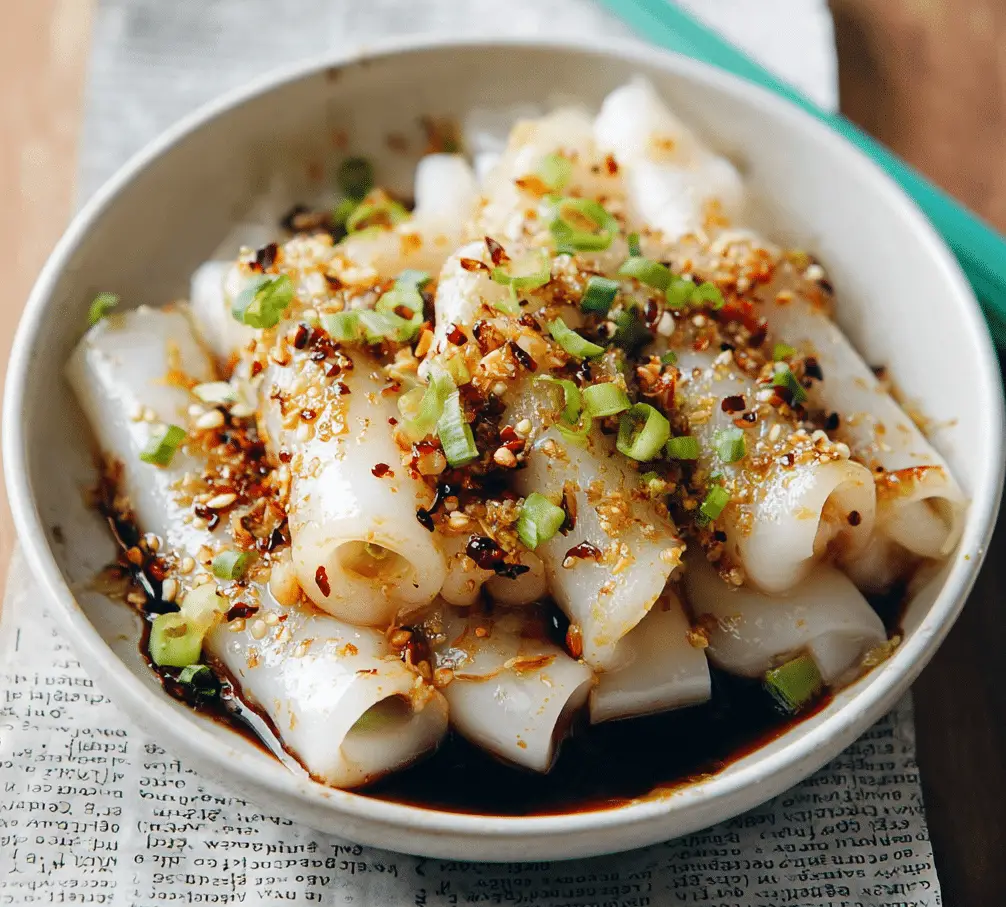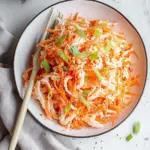The texture of Cheung Fun is what makes this dish unforgettable—soft, silky, and slightly chewy, it practically melts in your mouth. Popular at dim sum restaurants, these rice noodle rolls are traditionally served with a drizzle of sweet soy sauce and can be filled with anything from shrimp to BBQ pork or even just a sprinkle of green onions.
Making Cheung Fun at home might seem intimidating, but it’s much more accessible than it appears. With just a few basic ingredients and a simple steaming setup, you can recreate this dim sum staple right in your own kitchen. It’s naturally gluten-free, easily customizable, and perfect for impressing guests at brunch or enjoying a light meal anytime.
Full Recipe
Ingredients:
-
1 cup rice flour
-
2 tablespoons tapioca starch
-
1 tablespoon wheat starch
-
2 cups water
-
1/4 teaspoon salt
-
Neutral oil for greasing
-
2 scallions, finely chopped (optional for topping)
-
Sweet soy sauce (for serving)
Optional Fillings:
-
Shrimp (peeled and deveined)
-
Char siu (Chinese BBQ pork), finely chopped
-
Steamed vegetables, finely sliced (e.g. mushrooms, carrots, chives)
Directions:
-
In a large mixing bowl, whisk together the rice flour, tapioca starch, wheat starch, salt, and water until smooth. Let the batter rest for 30 minutes.
-
Prepare a steaming setup with a large wok or steamer, and place a flat tray or pan on a rack inside. Make sure it is level.
-
Lightly grease the tray with neutral oil before each roll. Pour a thin layer (about 3 tablespoons) of batter into the tray, tilting gently to evenly coat.
-
Cover and steam over high heat for 3–4 minutes, until the rice sheet becomes opaque and bubbly.
-
If using fillings, scatter them on the batter just before steaming.
-
Remove the tray, let it cool for about 1 minute, and use a rubber spatula to gently lift and roll the rice noodle sheet into a log.
-
Transfer to a plate and repeat until batter is used up.
-
Drizzle with sweet soy sauce and top with scallions before serving.
Prep Time: 10 minutes | Cooking Time: 25 minutes | Total Time: 35 minutes
Kcal: 185 kcal | Servings: 4 servings
Introduction to Cheung Fun – A Dim Sum Classic
Cheung Fun, also spelled as “Chee Cheong Fun,” is one of the most iconic dishes in Cantonese cuisine, often enjoyed as part of a traditional dim sum spread. These silky, steamed rice noodle rolls are typically served as a light breakfast or brunch option in southern China, especially in Hong Kong and Guangdong province. Their delicate texture, subtle flavor, and beautiful presentation make them a beloved choice for locals and international food lovers alike.
The name “Cheung Fun” literally translates to “intestine noodles,” a reference to the appearance of the rolled noodles rather than the contents. Despite the name, there’s nothing off-putting about this dish—it’s light, tender, and infinitely adaptable. The translucent sheets made from a simple blend of rice flour and starches are steamed to soft, chewy perfection and can be enjoyed plain or filled with various savory ingredients like shrimp, char siu (Chinese BBQ pork), or vegetables.
A Staple of Dim Sum Culture
In dim sum culture, Cheung Fun is a staple offering. It’s often delivered to the table hot and fresh, right off the steamers, sometimes served from traditional dim sum carts. You’ll find it in multiple forms: plain with a drizzle of soy sauce, filled with prawns or roast meats, or even topped with fried dough for a crunchy contrast.
Dim sum as a tradition is about small, shareable dishes, tea, and conversation—Cheung Fun fits into that tradition seamlessly. Its subtle flavors serve as a gentle palate cleanser among stronger-flavored dumplings, buns, and meats, while its versatility allows chefs to innovate with fillings and sauces.
Texture is Everything
What sets Cheung Fun apart from other noodle dishes is its texture. These rice rolls are made from a batter of rice flour, tapioca starch, and wheat starch, steamed into ultra-thin sheets that are both soft and springy. The resulting noodle is elastic and tender—when done right, it feels luxurious on the tongue.
The batter must be perfectly balanced to ensure a smooth consistency that won’t crack or become rubbery. The steaming process is also key: too long and the sheet becomes dry or sticky; too short and the noodle can tear or fall apart during rolling. Crafting Cheung Fun is a delicate art, and though it may take practice, it is deeply satisfying when mastered.
A Canvas for Customization
One of the great aspects of Cheung Fun is that it functions as a culinary canvas. It can be served plain with a drizzle of sweet soy sauce or enhanced with countless fillings. The most common traditional options include whole shrimp, minced pork, or Chinese BBQ meats. Vegetarian versions often include mushrooms, carrots, or chives, making it accessible to different dietary needs.
In recent years, modern adaptations have appeared in restaurants across Asia and globally. You’ll find Cheung Fun made with truffle oil, filled with crispy fried shallots, or topped with a spicy XO sauce. This shows just how versatile the dish is—it can remain humble and traditional or take on contemporary flavors without losing its core identity.
Naturally Gluten-Free and Allergy Friendly
For those with gluten sensitivities, Cheung Fun offers a naturally gluten-free base when wheat starch is replaced or omitted. The rice and tapioca starch combination makes it a great option for anyone avoiding wheat, and since it’s steamed rather than fried, it’s also lower in fat than many other dim sum options.
It’s also vegetarian- and vegan-friendly in its simplest form. When filled with vegetables or tofu, and paired with a soy-based sauce, it becomes an ideal light meal for a plant-based diet. This makes it suitable for a wide range of dietary lifestyles.
The Importance of the Sauce
A great Cheung Fun is not complete without the right sauce. The most common accompaniment is a light, sweet soy sauce that is gently poured over the noodles right before serving. This sauce enhances the subtle flavor of the rice rolls without overpowering them.
In Cantonese cuisine, sauces are more than just condiments—they’re integral to the dish. For Cheung Fun, the sweet soy sauce balances saltiness with just a touch of sugar and sometimes a dash of sesame oil. You may also find versions with hoisin, chili oil, or even peanut sauce in certain regions, especially in Malaysian or Singaporean adaptations.
Home Cooking vs. Restaurant Style
Making Cheung Fun at home is an entirely different experience from ordering it at a restaurant. While it may seem like an intimidating dish due to its delicate texture and precise steaming technique, it’s actually quite achievable with a few basic tools and patience.
Restaurants often use specialized steamers with rolling trays, but home cooks can mimic the effect with a large wok, a rack, and a shallow pan. Once you understand the batter consistency and timing, making rice noodle rolls becomes surprisingly meditative and rewarding. It’s a great way to bring a piece of the dim sum tradition into your own kitchen.
Regional Variations and Global Influence
While Cheung Fun originated in Guangdong, the dish has traveled and evolved significantly across Asia. In Malaysia, it’s known as “chee cheong fun” and often served with a thicker soy-based sauce, sometimes topped with sesame seeds or fried shallots. In Vietnam, a similar dish called “bánh cuốn” uses a slightly different batter but is still based on steamed rice sheets filled with savory ingredients.
Cheung Fun has also been embraced in Chinatowns and Asian fusion restaurants worldwide. You may find versions filled with avocado and tempura shrimp in California, or spicy versions with chili oil and garlic sauce in Taiwan. Each variation pays homage to the dish’s origins while adding a local twist.
Cultural Significance
In Chinese culture, food is often more than sustenance—it’s a way of maintaining tradition, expressing love, and connecting with family. Cheung Fun is frequently associated with breakfast outings or weekend dim sum meals, where family and friends gather around circular tables, sharing laughter and food.
It’s also a symbol of Cantonese culinary skill. A perfectly rolled Cheung Fun, served hot and glossy, is a mark of quality in any dim sum establishment. The dish bridges generations, with older family members teaching younger ones how to make the rolls, and stories shared over plates of steaming noodle rolls and tea.
Health Benefits and Nutritional Highlights
Cheung Fun offers a relatively light and healthy option in the often rich dim sum lineup. Made primarily from rice flour and water, it’s low in fat and calories when not heavily filled or sauced. Depending on the fillings used, it can also provide a decent amount of protein and fiber. For example, using shrimp adds lean protein, while vegetable versions provide vitamins and minerals.
The steaming method also keeps the calorie count low while preserving the texture and subtle flavors of the ingredients. If paired with a light dipping sauce and fresh greens or a hot bowl of broth, Cheung Fun becomes a wholesome, satisfying meal.
Conclusion: Why You Should Try Making Cheung Fun at Home
Cheung Fun is more than just a rice noodle roll—it’s a celebration of Cantonese culinary heritage. Whether you’re recreating it at home or savoring it at your favorite dim sum spot, each bite is a testament to the beauty of simplicity in food. The soft, silky texture paired with savory fillings and a light soy-based sauce creates a dish that’s as comforting as it is elegant.
For home cooks, Cheung Fun offers an opportunity to connect with a new technique and introduce variety into your cooking routine. It’s a great dish to serve at brunch or as a light lunch, and once you master the steaming and rolling technique, you can explore infinite variations based on your taste or dietary needs.
In today’s food culture where fusion, experimentation, and global flavors dominate, Cheung Fun stands strong as a humble, adaptable, and delicious classic. Try it once, and you’ll understand why it holds a cherished place in the hearts of dim sum lovers around the world.






